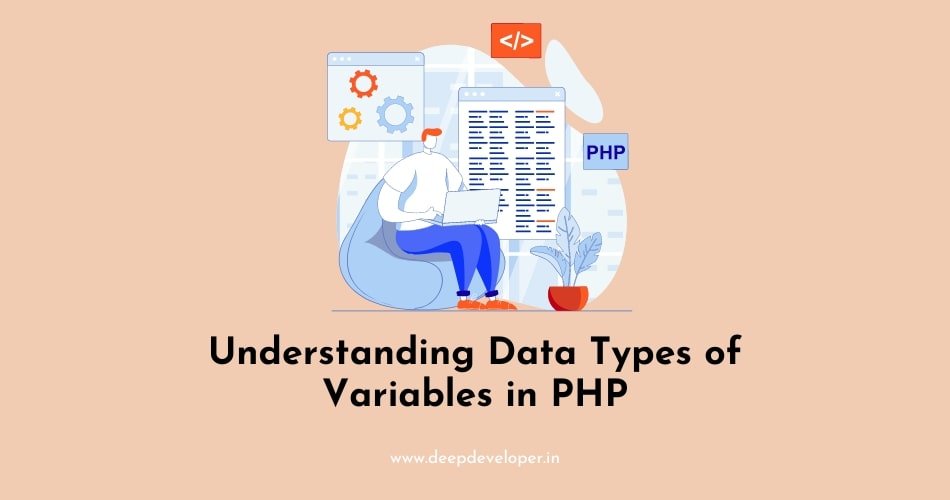Data types are fundamental concepts in programming that determine the type of values that can be stored in variables. In PHP, a popular server-side scripting language, variables can have different data types. In this blog, we will explore the common data types in PHP, along with examples, and understand how they are used.
Data Types of Variables in PHP
#1 Integer (int)
Integer represents whole numbers without decimal points. It can be a positive or negative number.
Example:
$age = 25; // an integer variable storing age
#2 Floating-Point Numbers (float)
Float represents numbers with decimal points. It is also known as a double in PHP.
Example:
$price = 10.99; // a floating-point variable storing price
#3 String
String represents a sequence of characters. It can be a combination of letters, numbers, or special characters, enclosed in single or double quotes.
Example:
$name = "John"; // a string variable storing a name
#4 Boolean (bool)
Boolean represents true or false values, indicating the state of a condition.
Example:
$is_active = true; // a boolean variable storing the status of an account
#5 Array
Array represents a collection of values stored in a single variable. It can hold multiple values of different data types, such as integers, strings, or other arrays.
Example:
$fruits = array("apple", "banana", "orange"); // an array variable storing a list of fruits
#6 Object
Object represents an instance of a class, which is a blueprint for creating objects in object-oriented programming (OOP). Objects have properties and methods.
Example:
class Car {
public $make;
public $model;
public $year;
}
$my_car = new Car(); // creating an object of the Car class
$my_car->make = "Toyota";
$my_car->model = "Camry";
$my_car->year = 2020;
#7 Null
Null represents the absence of a value. It is often used to indicate that a variable has no value or has not been assigned yet.
Example:
$gender = null; // a variable with no value assigned yet
#8 Resource
Resource represents a reference to an external resource, such as a database connection or a file handle. It is a special data type used to interact with external resources.
Example:
$file_handle = fopen("file.txt", "r"); // opening a file and storing the resource in a variable
#9 Callable
Callable represents a variable that can be invoked as a function or a method. It can store function names, anonymous functions, or methods.
Example:
$func = function($x, $y) {
return $x + $y;
};
$result = $func(5, 10); // invoking the anonymous function
#10 Iterable (added in PHP 7.1)
Iterable represents a data type that can be looped through, such as an array or an object implementing the Traversable interface.
Example:
$numbers = [1, 2, 3, 4, 5];
foreach ($numbers as $number) {
echo $number . " ";
}
It’s important to note that PHP is a dynamically typed language, which means that you don’t need to explicitly declare the data type of a variable before using it. PHP automatically determines the data type based on the value assigned to the variable. However, you can also explicitly specify the data type of a variable using type hinting in function arguments or class properties in PHP 7 and later versions.
Best practices to keep in mind when working with data types in PHP
Choose the appropriate data type: Use the most suitable data type for the kind of data you are storing in a variable. For example, use integers for whole numbers, strings for text, booleans for true/false values, and arrays for collections of values.
Be mindful of type casting: PHP allows automatic type casting in some cases, but it’s important to understand how type casting works to avoid unexpected behavior. For example, when performing arithmetic operations with mixed data types, PHP may automatically cast one type to another, leading to unintended results.
Validate and sanitize user input: When accepting user input in your PHP applications, always validate and sanitize the input to ensure that it matches the expected data type. This helps prevent security vulnerabilities such as SQL injection or cross-site scripting (XSS) attacks.
Use type hinting in function arguments and class properties: PHP 7 and later versions support type hinting, which allows you to specify the expected data type of function arguments or class properties. This can help improve the reliability and readability of your code by providing clear indications of the expected data types.
Be mindful of performance considerations: Some data types in PHP, such as arrays and objects, can have performance implications. For example, using associative arrays with a large number of keys can impact performance, so it’s important to choose the right data type for the specific use case to optimize performance.
Also Read:
Conclusion:
In conclusion, understanding the different data types in PHP and how to use them correctly is essential for effective programming. By choosing the appropriate data types, validating and sanitizing user input, using type hinting, and considering performance implications, you can write robust and efficient PHP code. Happy coding!

